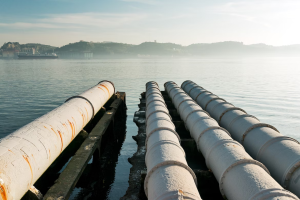
Pipeline transport is a widely used mode of transportation for goods, such as oil, gas, and chemicals in various industries. Compared to other transport modes, such as road, rail, and air, pipelines can offer several advantages and disadvantages, depending on the type of material being transported and the specific needs of the industry.
Advantages of Pipeline Transport
- Efficiency: One of the primary advantages of pipeline transport is its efficiency. A pipeline can transport vast amounts of material over long distances in a short period. This is especially advantageous for industries that require the transportation of large volumes of goods across extended distances, such as the oil and gas industry.
- Reduced Costs: Pipeline transport is usually much cheaper than other modes of transportation, such as road and air transportation. Pipeline transport requires minimal labor and is less dependent on fuel and energy costs associated with other modes of transportation.
- Safety: Pipelines are much safer than other modes of transportation, as they minimize the risk of accidents, spills, and injuries. The closed and continuous system of pipelines minimizes the chances of external factors interfering with the goods being transported, ensuring that products reach their destination without any contamination.
Disadvantages of Pipeline Transport
- Limited Flexibility: One of the main disadvantages of pipeline transport is its limited flexibility. Unlike other modes of transportation, pipelines cannot be redirected easily, and any modification to the pipeline network requires significant investment. This lack of flexibility can pose challenges for industries that need quick and frequent changes to their transportation routes and schedules.
- High Initial Investment: Building a pipeline network requires a significant amount of capital investment. The initial cost of setting up a pipeline is much higher than other modes of transportation, and maintenance also requires substantial capital investment. This can pose a challenge for businesses that do not have the capacity to bear these costs.
- Maintenance: pipeline require specialized components and equipment, such as industrial butterfly valves, to maintain their efficiency and structural integrity. Industrial butterfly valves help control the flow of material within the pipeline and protect against leaks and contamination. However, maintenance can be time-consuming and expensive to ensure that valves remain in excellent condition.
Role of Industrial Butterfly Valves in Pipeline Transport
Industrial butterfly valves play a significant role in pipeline transport. They are designed to control the flow of material through the pipeline and ensure that products are transported efficiently and safely. There are two primary types of butterfly valves that are used in pipeline systems:
- Wafer Butterfly Valve: This type of valve is designed to fit between two flanges without any extending bolt holes. They are relatively compact and can be installed in tight spaces. They are also lightweight, making them ideal for use in pipelines that need low flow rates.
- Lug Butterfly Valve: This type of valve has threaded inserts on each valve end that allow it to be bolted into the system using two sets of bolts. They are heavy-duty and can handle a substantial amount of pressure.
Conclusion
Pipeline transport is a versatile and efficient mode of transportation that is widely used in various industries. While it has several advantages, such as efficiency, cost-effectiveness, and safety, it also has several disadvantages, such as limited flexibility and high initial investment costs. To ensure their efficiency, pipelines must have adequate equipment in place, such as industrial butterfly valves, to maintain their integrity and ensure safe transportation of goods.




Leave a Reply